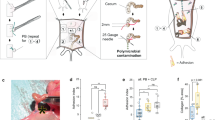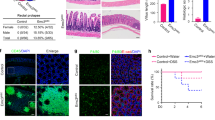Abstract
The profound intestinal epithelial defects in the newborn epidermal growth factor receptor (EGFR) knockout mouse suggests that EGFR signaling plays important roles in embryonic gut development. Herein, we further elucidated the function of EGFR signaling on early embryonic gut development by comparing the effects of 1–10 ng/mL of exogenous epidermal growth factor (EGF) or 10–25 μM of the tyrphostin 3,4,5 trihydroxybenzene malononitrile, a specific inhibitor of EGFR tyrosine kinase, on intact E12 Swiss-Webster mouse midgut grown in chemically defined organ culture using Fitton-Jackson BGJb medium for 4 or 6 d. Intestinal development during culture was assayed by morphometry, histology, reverse transcription/competitive PCR for villin and intestinal fatty acid binding protein mRNA, and immunohistochemistry for epithelial proliferative markers. During organ culture, control specimens grew in length, developed smooth muscle, simple columnar epithelial and goblet cell phenotypes, showed early villus formation in the proximal intestine, and increased expression of villin and intestinal fatty acid binding protein mRNA. EGF failed to significantly alter small intestinal lengthening, whereas EGF 10 ng/mL inhibited colonic length growth. Tyrphostin 25 μM resulted in regional losses of stromal and smooth muscle cells in the small intestine and absent colonic goblet cells. In controls, cellular proliferation initially occurred throughout the small intestinal epithelium but became increasingly localized to the intervillus crypt regions. This sequestration of epithelial proliferation into crypts was much more apparent in EGF-treated versus tyrphostin-treated specimens. EGFR activation, therefore, appears to accelerate the maturation rate of goblet cells and the differential crypt/villus proliferation pattern in early embryonic mouse gut.
Similar content being viewed by others
Log in or create a free account to read this content
Gain free access to this article, as well as selected content from this journal and more on nature.com
or
Abbreviations
- BrdU:
-
bromodeoxyuridine
- EGF:
-
epidermal growth factor
- EGFR:
-
epidermal growth factor receptor
- HBSS:
-
Hanks' balanced salt solution
- iFABP:
-
intestinal fatty acid binding protein
- PCNA:
-
proliferating cell nuclear antigen
- RT:
-
reverse transcription
References
Miettinen PJ, Berger JE, Meneses J, Phung Y, Pedersen RA, Werb Z, Derynck R 1995 Epithelial immaturity and multiorgan failure in mice lacking epidermal growth factor receptor. Nature 376: 337–341.
Kliegman RM, Fanaroff AA 1981 Neonatal necrotizing enterocolitis: a nine-year experience. Am J Dis Child 135: 603–607.
Pollack PF, Goda T, Colony PC, Edmond J, Thornburg W, Korc M, Koldovsky O 1987 Effects of enterally fed epidermal growth factor on the small and large intestine of the suckling rat. Regul Pept 17: 121–132.
Foltzer-Jourdainne C, Garaud JC, Nsi-Emvo E, Raul F 1993 Epidermal growth factor and the maturation of intestinal sucrase in suckling rats. Am J Physiol 265: G459–G466.
Emvo EN, Raul F, Koch B, Neuville P, Foltzer-Jourdainne C 1996 Sucrase-isomaltase gene expression in suckling rat intestine: hormonal, dietary, and growth factor control. J Pediatr Gastroenterol Nutr 23: 262–269.
Threadgill DW, Dlugosz AA, Hansen LA, Tennenbaum T, Lichti U, Yee D, LaMantia C, Mourton T, Herrup K, Harris RC, Barnard JA, Yuspa SH, Coffey RJ, Magnuson T 1995 Targeted disruption of mouse EGF receptor: effect of genetic background on mutant phenotype. Science 269: 230–234.
Hormi K, Lehy T 1994 Developmental expression of transforming growth factor-alpha and epidermal growth factor receptor proteins in the human pancreas and digestive tract. Cell Tissue Res 278: 439–450.
Chailler P, Ménard D 1999 Ontogeny of EGF receptors in the human gut. Front Biosci 4: D87–D101.
Beaulieu JF, Ménard D, Calvert R 1985 Influence of epidermal growth factor on the maturation of the fetal mouse duodenum in organ culture. J Pediatr Gastroenterol Nutr 3: 476–481.
Menard D, Arsenault P, Gallo-Payet N 1986 Epidermal growth factor does not act as a primary cue for inducing developmental changes in suckling mouse jejunum. J Pediatr Gastroenterol Nutr 5: 949–955.
Beaulieu JF, Calvert R 1981 The effect of epidermal growth factor (EGF) on the differentiation of the rough endoplasmic reticulum in fetal mouse small intestine in organ culture. J Histochem Cytochem 29: 765–770.
Conteas CN, DeMorrow JM, Majumdar AP 1986 Effect of epidermal growth factor on growth and maturation of fetal and neonatal rat small intestine in organ culture. Experientia 42: 950–952.
Ménard D, Arsenault P, Pothier P 1988 Biologic effects of epidermal growth factor in human fetal jejunum. Gastroenterology 94: 656–663.
Ménard D, Corriveau L, Arsenault P 1990 Differential effects of epidermal growth factor and hydrocortisone in human fetal colon. J Pediatr Gastroenterol Nutr 10: 13–20.
Tremblay E, Monfils S, Menard D 1997 Epidermal growth factor influences cell proliferation, glycoproteins, and lipase activity in human fetal stomach. Gastroenterology 112: 1188–1196.
Goodlad RA, Wright NA 1996 Epidermal growth factor (EGF). Baillieres Clin Gastroenterol 10: 33–47.
Barnard JA, Beauchamp RD, Russell WE, Dubois RN, Coffey RJ 1995 Epidermal growth factor-related peptides and their relevance to gastrointestinal pathophysiology. Gastroenterology 108: 564–580.
Uribe JM, Barrett KE 1997 Nonmitogenic actions of growth factors: an integrated view of their role in intestinal physiology and pathophysiology. Gastroenterology 112: 255–268.
Beardmore JM, Richards RC 1983 Concentrations of epidermal growth factor in mouse milk throughout lactation. J Endocrinol 96: 287–292.
Hofmann GE, Abramowicz JS 1990 Epidermal growth factor (EGF) concentrations in amniotic fluid and maternal urine during pregnancy. Acta Obstet Gynecol Scand 69: 217–221.
Popliker M, Shatz A, Avivi A, Ullrich A, Schlessinger J, Webb CG 1987 Onset of endogenous synthesis of epidermal growth factor in neonatal mice. Dev Biol 119: 38–44.
Gazit A, Yaish P, Gilon C, Levitzki A 1989 Tyrphostins I: synthesis and biological activity of protein tyrosine kinase inhibitors. J Med Chem 32: 2344–2352.
Theiler K 1989 The House Mouse. Springer-Verlag, New York, 87–93.
Warburton D, Seth R, Shum L, Horcher PG, Hall FL, Werb Z, Slavkin HC 1992 Epigenetic role of epidermal growth factor expression and signaling in embryonic mouse lung morphogenesis. Dev Biol 149: 123–133.
Zhao J, Nishimoto SK 1995 An RNA-competitive polymerase chain reaction method for human matrix gamma-carboxyglutamic acid protein mRNA measurement. Anal Biochem 228: 162–164.
Weaver LT 1996 Anatomy and embryology. In: Walker WA, Durie PR, Hamilton JR, Walker-Smith JA, Watkins JB(eds) Pediatric Gastrointestinal Disease: Pathophysiology, Diagnosis, Management. Mosby-Year Book, St. Louis, 9–30.
Chai Y, Bringas P, Shuler C, Devaney E, Grosschedl R, Slavkin HC 1998 A mouse mandibular culture model permits the study of neural crest cell migration and tooth development. Int J Dev Biol 42: 87–94.
Canoun C, Ma C, Halpern D, Shum L, Bringas P, Sank A, Slavkin HC 1993 Endogenous epidermal growth factor regulates limb development. J Surg Res 54: 638–647.
Green RP, Cohn SM, Sacchettini JC, Jackson KE, Gordon JI 1992 The mouse intestinal fatty acid binding protein gene: nucleotide sequence, pattern of developmental and regional expression, and proposed structure of its protein product. DNA Cell Biol 11: 31–41.
Maunoury R, Robine S, Pringault E, Huet C, Guenet JL, Gaillard JA, Louvard D 1988 Villin expression in the visceral endoderm and in the gut anlage during early mouse embryogenesis. EMBO J 7: 3321–3329.
Isaacs HV, Pownall ME, Slack JMW 1998 Regulation of Hox gene expression and posterior development by the Xenopus caudal homologue Xcad3. EMBO J 17: 3413–3427.
Scheving LA, Shiurba RA, Nguyen TD, Gray GM 1989 Epidermal growth factor receptor of the intestinal enterocyte. J Biol Chem 264: 1735–1741.
Kelly D, McFadyen M, King TP, Morgan PJ 1992 Characterization and autoradiographic localization of the epidermal growth factor receptor in the jejunum of neonatal and weaned pigs. Reprod Fertil Dev 4: 183–191.
Hemlrath MA, Erwin CR, Warner BW 1997 A defective EGF-receptor in waved-2 mice attenuates intestinal adaptation. J Surg Res 69: 76–80.
Luetteke NC, Phillips HK, Qiu TH, Copeland NG, Earp HS, Jenkins NA, Lee DC 1994 The mouse waved-2 phenotype results from a point mutation in the EGF receptor tyrosine kinase. Genes Dev 8: 399–413.
Erwin CR, Helmrath MA, Shin CE, Falcone RA, Stern LE, Warner BW 1999 Intestinal overexpression of EGF in transgenic mice enhances adaptation after small bowel resection. Am J Physiol 277: G533–G540.
Kelly SM, Hunter JO 1990 Epidermal growth factor stimulates synthesis and secretion of mucus glycoproteins in human gastric mucosa. Clin Sci Colch 79: 425–427.
Procaccino F, Reinshagen M, Hoffmann P, Zeeh JM, Lakshmanan J, McRoberts JA, Patel A, French S, Eysselein VE 1994 Protective effect of epidermal growth factor in an experimental model of colitis in rats. Gastroenterology 107: 12–17.
Acknowledgements
The authors thank Pablo Bringas, Jr., Valentino Santos, Dr. Guillermo Flores-Delgado, and Dr. Jingsong Zhao at the Center for Craniofacial Molecular Biology (CCMB), University of Southern California School of Dentistry for technical advice. Dr. Zhao also generously supplied the β-actin competitor and primers for competitive PCR.
Author information
Authors and Affiliations
Additional information
Supported by the Childrens Hospital Los Angeles Research Institute and the Good Hope Medical Foundation.
Rights and permissions
About this article
Cite this article
Duh, G., Mouri, N., Warburton, D. et al. EGF Regulates Early Embryonic Mouse Gut Development in Chemically Defined Organ Culture. Pediatr Res 48, 794–802 (2000). https://doi.org/10.1203/00006450-200012000-00016
Received:
Accepted:
Issue date:
DOI: https://doi.org/10.1203/00006450-200012000-00016
This article is cited by
-
Ciliary Hedgehog signaling patterns the digestive system to generate mechanical forces driving elongation
Nature Communications (2021)
-
Inhibition of EGFR signaling abrogates smooth muscle proliferation resulting from sustained distension of the urinary bladder
Laboratory Investigation (2006)



